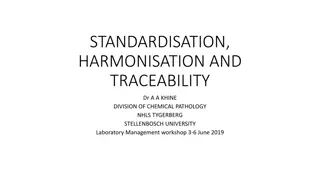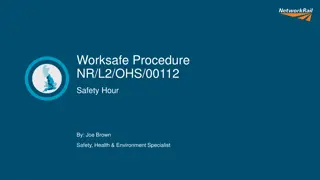History and Educational Programs of DEU Lab Animal Science Department
Established in 2004, the Department of Laboratory Animal Science at Dokuz Eylul University Institute of Health Sciences offers cutting-edge education focusing on animal welfare and ethical practices in scientific research. The department upholds the 3R Principle—Reduction, Refinement, Replacement�
0 views • 9 slides
Parliamentary Procedure
Learn about the role, principles, and importance of parliamentary procedure in running effective meetings. Explore the basics of Robert's Rules of Order, agenda building, the relationship between parliamentary procedure and the Brown Act, and tools for chairs to facilitate discussions and decision-m
1 views • 25 slides
Laboratory Material Quality Management Procedures
This detailed guide covers the comprehensive process management and quality control procedures for laboratory materials, including the life cycle of materials, purchase processes, vendor evaluation, reception and storage guidelines, and evaluation criteria. It emphasizes the importance of documented
1 views • 20 slides
Effective Laboratory Management: Safety, Equipment Maintenance, and Inventory Control
This comprehensive training manual covers essential topics such as laboratory safety, equipment maintenance, supplies and reagents inventory, chemical inventory management, and material safety data sheets. It emphasizes the importance of proper procedures to ensure a safe working environment and eff
2 views • 19 slides
Overview of Common Procedure for Requesting COAMU Advice
This content provides information on the common procedure for requesting COAMU advice in the Brabant Wallon, Hainaut, Namur, Liège, and Luxembourg regions. It covers topics such as the legal basis, reasons for procedure reform, principles of the new procedure, and steps for implementation. Key poin
10 views • 16 slides
Optimizing Laboratory Billing Services, The Key to Efficient Healthcare Revenue Management
In the intricate web of healthcare management, laboratory billing services play a pivotal role. From accurately documenting procedures to ensuring compliance with complex insurance regulations, effective billing is essential for the financial health of laboratories and the overall healthcare system.
2 views • 8 slides
WHONET Training Course: Laboratory Configuration and Setup
Understanding the laboratory configuration process in WHONET is crucial for effective data entry and analysis. This module guides users on setting up a new laboratory, entering country and lab details, defining antibiotics, sample locations, and data fields, creating microbiological alerts, and savi
3 views • 57 slides
Streamlining Laboratory Billing Services, Key Benefits and Best Practices
In the fast-paced environment of medical laboratories, accurate and efficient billing processes are essential. Laboratory billing services are crucial in ensuring financial stability and compliance with healthcare regulations. This blog explores the benefits of professional laboratory billing servic
1 views • 7 slides
Enhancing Laboratory Billing Services with MedKarma, A Comprehensive Guide
In the dynamic healthcare landscape, laboratory billing services play a crucial role in ensuring smooth financial operations for medical laboratories. Effective billing practices not only streamline revenue cycles but also enhance overall operational efficiency. MedKarma, a leading provider of labor
4 views • 7 slides
Revolutionizing Laboratory Billing Services with Medkarma, Precision, Efficiency, and Transparency
In the ever-evolving healthcare landscape, laboratory billing services stand as a critical component in ensuring the financial health of diagnostic labs. The complexity of billing processes, coupled with stringent compliance requirements, demands a specialized approach. Medkarma, a leader in healthc
2 views • 7 slides
Laboratory Automation in Chemical Pathology: A Comprehensive Overview
Laboratory automation in chemical pathology involves the use of control systems to minimize human intervention and improve efficiency in conducting tests. The historical background, types of automation, benefits, total laboratory automation, and important considerations are discussed in detail.
3 views • 25 slides
Best Practices for Laboratory Safety and Management
Promoting a safe laboratory environment involves following safety codes and assigning responsibilities for practices like hazard awareness, equipment use, and PPE. Good laboratory practices include proper storage and handling of hazardous chemicals, with a focus on flammable, corrosive, reactive, an
4 views • 17 slides
Quality Assurance in Virology Laboratory
This chapter focuses on quality assurance in virology laboratory, covering topics such as quality control, documentation of test results, laboratory safety rules, and more. It explains the types of quality control, quality assurance cycle, and process areas of quality assurance in laboratory testing
3 views • 19 slides
Formalin Safety Guidelines in Anatomy and Physiology Laboratory
Formalin, a mixture of formaldehyde and water, is used in laboratories to preserve tissues. OSHA regulates exposure levels due to health risks. Proper ventilation and personal protective equipment are crucial to control exposure. The laboratory employs engineering controls and monitoring for safety.
1 views • 16 slides
Laboratory Equipment E-Catalog 2019
Explore the E-Catalog featuring various laboratory equipment such as the Analyticon Biolyzer 100 Chemistry Analyzer, Boeco Centrifuge C28A, and Eschweiler Blood Gas Analyzer. View specifications, prices, education materials, and procedures for these advanced laboratory tools. The catalog includes es
2 views • 7 slides
Achieving Comparable Results in Laboratory Practice
Good laboratory practice necessitates minimal error in measurement to reflect a patient's biological condition accurately, ensuring comparable and reliable results regardless of testing location or method. Standardization, harmonization, and traceability play crucial roles in achieving uniformity an
1 views • 29 slides
Best Practices for Clinical Laboratory Specimen Handling
Good clinical laboratory practice emphasizes the proper collection, storage, and transportation of laboratory specimens to ensure accurate and reliable test results. Key aspects include obtaining high-quality specimens, maintaining specimen integrity, and following standard precautions to prevent co
6 views • 6 slides
Worksafe Procedure NR/L2/OHS/00112 Safety Hour Overview
The Worksafe Procedure NR/L2/OHS/00112 was introduced in 2009 to empower Network Rail employees to raise safety concerns and stop work if necessary. This procedure ensures a safe work environment by allowing employees to assess risks, establish safe work practices, and receive support from managemen
0 views • 8 slides
Comprehensive Resources for Medical Laboratory Technicians
Extensive resources are available for medical laboratory technicians, including tutorials for evaluating health information, access to credible research libraries, and free professional publications. Specific resources cover phlebotomy techniques, hematology tutorials, blood banking procedures, and
1 views • 7 slides
Essential Laboratory Apparatus and Equipment for Sugar Processing Controllers
The analytical results obtained from the laboratory play a crucial role in ensuring the smooth and effective functioning of sugar extraction and processing operations. Understanding and utilizing laboratory apparatus and equipment are key aspects of the Sugar Processing Controller's role, enabling t
0 views • 72 slides
Laboratory Safety Guidelines and Procedures for Chemistry Students
Laboratory safety is crucial in chemistry courses to prevent accidents and ensure a safe working environment. This guide includes marking criteria, laboratory regulations, emergency procedures, safety rules, and lab tools. It emphasizes the importance of following safety protocols, handling equipmen
1 views • 39 slides
Laboratory Safety Guidelines for Research Professionals
Safety in the laboratory is a fundamental aspect that requires a culture of responsibility and awareness. This comprehensive guide by Prof. Frank J. Dekker covers general safety principles, the importance of protective clothing, and what to do in case of accidents. Emphasizing the significance of aw
0 views • 18 slides
Insights into Hematology Laboratory Practice
This resource explores the potential role of hematologists in laboratory settings, discussing board certification, advantages, challenges, current training trends, and core curriculum lectures in hematology. It sheds light on the critical areas of laboratory training, emphasizing the importance of u
0 views • 9 slides
Laboratory-Acquired Infections: Routes of Exposure and Prevention Measures
The content discusses laboratory-acquired infections from 1930 to 2015 and highlights exposure routes such as facial mucous membranes, percutaneous, ingestion, inhalation, and non-traditional routes like eye and nasal cavity. It emphasizes the importance of biosafety practices, identifies GI pathoge
0 views • 21 slides
Overview of Control System at FREIA Laboratory
The control system at FREIA Laboratory in Uppsala, Sweden, includes a comprehensive infrastructure with hardware and software components such as HP ProLiant servers, Siemens PLCs, Epics-based software, and a network setup with public subnets and WLANs. The system is utilized for measurement automati
2 views • 14 slides
Laboratory Related CRFs for Pharmacokinetics Study
This collection encompasses various CRFs related to laboratory procedures in the context of Pharmacokinetics for a study. It includes forms for enrollment, specimen storage, safety laboratory results, and specific days for sample collection. The CRFs detail the storage, collection, and documentation
1 views • 14 slides
Helix Diagnostics: State-of-the-Art Clinical Laboratory in Michigan
Helix Diagnostics, founded in 2015 and located in Waterford Township, Michigan, is a cutting-edge clinical laboratory offering services such as therapeutic drug monitoring, blood chemistry testing, pharmacogenomics, and molecular pathogen detection. With over 125 employees, they serve a wide range o
1 views • 11 slides
Lumbar Puncture: Procedure, Complications, and Clinical Applications
Lumbar puncture, also known as LP, is an invasive procedure used to obtain cerebrospinal fluid (CSF) for diagnostic and therapeutic purposes. This procedure has a long history dating back to ancient times, with modern techniques developed in the late 19th century by Heinrich Quincke. LP is crucial f
2 views • 11 slides
Lumbar Puncture: Indications, Contraindications, and Post-procedure Considerations
Lumbar puncture is a medical procedure involving the insertion of a needle into the spinal subarachnoid space to collect cerebrospinal fluid for diagnostic or therapeutic purposes. Indications for performing a lumbar puncture include suspicion of meningitis, subarachnoid hemorrhage, CNS diseases lik
0 views • 17 slides
Comprehensive Guide to Setting Up a K-6 STEM Laboratory
In this STEM lab design project, elementary schools are provided with a comprehensive booklet to help them establish a K-6 STEM laboratory. The booklet comprises five parts - Introduction, Description of the Space, Tools & Materials, Safety, and Resources. It covers the essence of STEM education, th
1 views • 14 slides
Laboratory Safety and Guidelines in Medical Chemistry
The aim of the Medical Chemistry Laboratory is to provide students with practical observations, skills, and techniques related to substances and their reactions discussed in lectures and textbooks. Essential safety rules are outlined to ensure a secure working environment, emphasizing proper handlin
0 views • 5 slides
Effective Laboratory Inventory Management Practices
Understanding the significance of laboratory inventory management practices is crucial for compliance, efficiency, safety, and cost-effectiveness. This chapter delves into the importance of inventory management, defining key terms, and discussing monitoring, control, and recording of laboratory stoc
1 views • 51 slides
Trial of Warrant Cases by Magistrates under the Code of Criminal Procedure 1973
The Code of Criminal Procedure 1973 Chapter 19 outlines the procedure for trial of warrant cases by magistrates where the prosecution presents evidence to support the case against the accused. Section 244 requires the magistrate to hear the prosecution and take all evidence presented. If the evidenc
0 views • 12 slides
Laboratory General Safety and Precautions
Microbiology involves the study of microorganisms such as bacteria, fungi, viruses, and parasites. It is crucial to maintain strict safety protocols in the laboratory to prevent contamination and ensure the well-being of individuals handling these potentially pathogenic organisms. Rules like wearing
0 views • 26 slides
Recognizing Laboratory Hazards: Physical Hazards and Corrosive Chemicals
Laboratory hazards, particularly physical hazards and corrosive chemicals, pose risks to individuals working in laboratory settings. Corrosives, such as acids, bases, oxidizing agents, and gases, can cause significant harm to eyes and skin. Proper precautions and handling procedures are crucial to m
0 views • 16 slides
Laboratory Animal Genetics and Research Importance
This course (AGB 610) delves into the realm of laboratory animal breeding, exploring the significance of using animals in research and teaching. Dr Shanker Dayal, a distinguished professor, guides students through lectures on animal genetics and the common uses of laboratory animals. The course emph
1 views • 14 slides
A-29 Emergency Procedure: Overpressure (CAB PRES)
An overview of the emergency procedure for overpressure (CAB PRES) in the A-29 aircraft. The procedure outlines actions to take when cockpit differential pressure exceeds 5.75 psi, including switching off the air conditioning, maintaining a maximum altitude of 25,000 ft, and following the SUPPLY FAI
0 views • 4 slides
Exploring the Role and Objectives of Laboratory Teaching
The content delves into the various perspectives on laboratory teaching, its aims, pedagogical levels, and common challenges faced. It discusses specific aims of laboratory teaching, including familiarization with equipment, teaching experimental work attitudes, and training in observation and deduc
1 views • 32 slides
Guidelines for Nomenclature of Laboratory Mouse and Rat Strains
Laboratory mice and rat strains have specific nomenclature guidelines to account for their genetic backgrounds and origins. Mouse strains are registered through the Mouse Genome Database, while rat strains are registered through the Rat Genome Database. The use of Laboratory Registration Codes is cr
0 views • 14 slides
Haemostasis Laboratory Offerings in Liver Disease
In this study, various laboratory offerings in liver disease and their implications on haemostasis are explored. The research covers traditional laboratory measures, platelet aggregation, platelet function, thrombin generation, thromboelastometry, FIBTEM, and inter-patient variability. Hierarchical
0 views • 16 slides







































